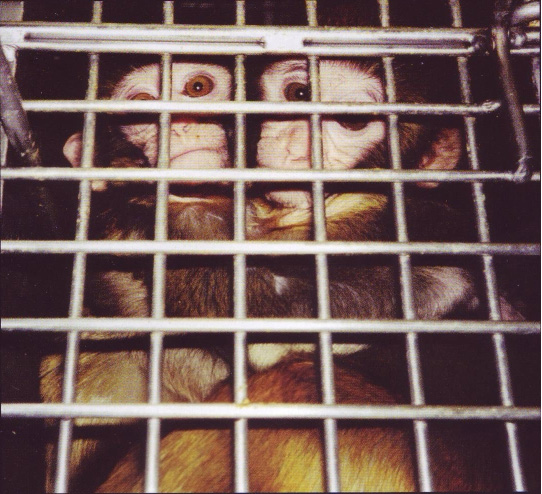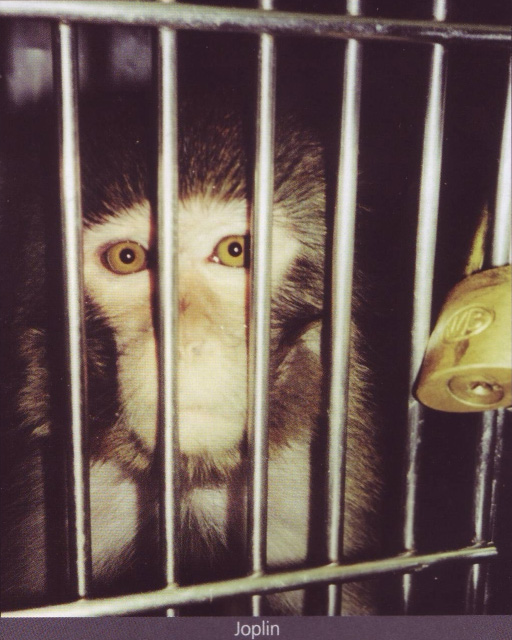Slaughter of the Innocent
Part b
 The laboratory environment caused monkeys to display depression, aggression and bizarre behavior such as penis-sucking, pacing, circling, rocking, drinking their urine, eating and painting with their feces, abusing their offspring, eye-poking, pulling their hair out, and biting and attacking themselves. I used all the interventions afforded me - toys, feeder devices and bits of wood - to improve the self-abusive behavior, but with only two staff caring for 1,500 individually caged animals, these interventions proved useless, and it became obvious that the well-being program was failing.
The laboratory environment caused monkeys to display depression, aggression and bizarre behavior such as penis-sucking, pacing, circling, rocking, drinking their urine, eating and painting with their feces, abusing their offspring, eye-poking, pulling their hair out, and biting and attacking themselves. I used all the interventions afforded me - toys, feeder devices and bits of wood - to improve the self-abusive behavior, but with only two staff caring for 1,500 individually caged animals, these interventions proved useless, and it became obvious that the well-being program was failing.
One tragic example of this failure was named Snicker, one of 28 capuchin monkeys who had all spent more than 20 years being injected with psychotropic, mind-altering drugs. In tiny isolated cages in a dank, wretched room of the research annex building, they were driven mad.
They all coped in different ways; Snicker was self-destructive. She would incessantly lick a spot, sometimes on a foot, or her leg, until it was a deep bleeding wound. I tried everything to stop her, but each time bandages were applied, she would just move above or below the old injury and start licking, opening up another sore. When one would heal, she would start another. At least once she had bitten off the end of a finger in an adverse reaction to the drugs.
I will never forget the day I entered the room and found Snicker collapsed in a pool of her own blood, shaking like a leaf at the bottom of her cage. The morning technician who had done health checks had reported nothing, but she had obviously been there a long time. I scooped her dying body up in a towel and rushed her to the clinic. She was suffering, but the veterinarian refused to humanely euthanise her without the researcher's permission. I heard it took hours for her to die. It has happened here in the UK recently in the Oxford laboratory, and it's played out day after day in research labs around the world.
Although the sheer number of monkeys made it impossible to get to know more than a handful of them personally, I am privileged to have had the chance to get to know a few of them and it's very important that I share with you another individual's story. I called her Joplin, but to the researchers she was known only as monkey number 20600. She was stolen from the wild and shipped from Beijing with a shipment of 100 other Chinese-origin rhesus macaques to the US. These monkeys were unlike any of the other captive-bred macaques I was familiar with. They were lean and well muscled with faces suntanned from an active life outdoors. They were totally naive to the cage and were completely bewildered, literally smashing from one side of the cage to the other in a desperate attempt to escape.
 But Joplin was unique, and I noticed her immediately. When all the others in her shipment were cowering in the far corner of their tiny cage, Joplin sat stoic at the front and stared me down with a calm defiant look directly in the eye, unheard of in any non-human primate. I paid close attention to her as she was moved out of quarantine and assigned to a research protocol.
But Joplin was unique, and I noticed her immediately. When all the others in her shipment were cowering in the far corner of their tiny cage, Joplin sat stoic at the front and stared me down with a calm defiant look directly in the eye, unheard of in any non-human primate. I paid close attention to her as she was moved out of quarantine and assigned to a research protocol.
I stole time to visit her and others from her group and give extra treats they would otherwise never get. She never trusted me and even when receiving extra food she took every opportunity to try to scratch me. No wonder - I was her predator and her defiance earned her a sign on her cage that read "dangerous." When they started doing regular hormone injections and blood draws she started to mutilate her own ankles near the injection site. Then she had 2 grand maul seizures. I asked the veterinarian to take her off the protocol because of these problems but the researcher refused.
Eventually, after the protocol was over, Joplin was killed like so many before her. She was injected with a massive dose of barbiturates, taken to the necropsy room and placed on a cold, steel table with a built-in drain. A technician cut Joplin's major femoral arteries and waited while her still-beating heart pumped the life blood from her now limp body. (This process is called "bleeding out"; animals used in research are bled to death). Her tissues and body parts were divided into plastic bags and put on ice in an igloo cooler to be translated later into "scientific" data.